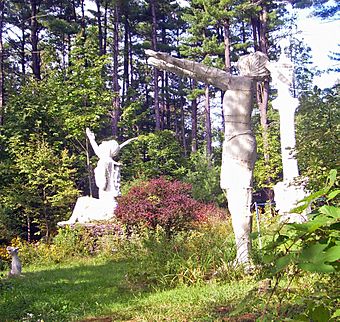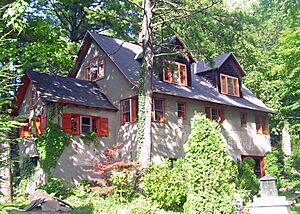Emile Brunel Studio and Sculpture Garden facts for kids
Quick facts for kids |
|
|
Emile Brunel Studio and Sculpture Garden
|
|

Natache (left), Moon Haw Haw and
Great White Spirit, 2008 |
|
| Location | Boiceville, New York |
|---|---|
| Nearest city | Kingston |
| Area | 1.3 acres (5,300 m2) |
| Built | 1918–47 |
| Architect | Emile Brunel |
| Architectural style | Arts and Crafts |
| NRHP reference No. | 99000909 |
| Added to NRHP | 1999 |
The Emile Brunel Studio and Sculpture Garden is a special place in Boiceville, New York. It's also known by other names like the Totem Indian Trading Post or Brunel Park. This unique site has seven large sculptures and three buildings. It's located on Da Silva Road, close to NY 28.
Emile Brunel was an artist who came to the United States from France. He became very interested in the Native American tribes of the West during his travels. After a successful career as a photographer, he bought land in the Catskills. There, he built his studio, home, and a resort. He decorated the resort with sculptures inspired by the Native American art he had seen.
The resort closed after World War II when Route 28 was made wider. The statues were moved to their current spot. Even after the resort closed, the sculpture garden remained a popular place for travelers to stop and visit. In 1929, Brunel started building his studio and home. After he passed away in 1944, his wife and daughter, both named Gladyse, took care of the sculpture garden. They also ran a souvenir shop nearby until 1985. Brunel's home and studio are still standing today. They were added to the National Register of Historic Places in 1999 because of their historical importance.
Contents
What's at the Property?
The studio and sculpture garden are on a 1.3-acre (5,300 m2) piece of land. It's located where Da Silva Road meets Route 28, about a half-mile (1 km) south of Boiceville. The area is mostly covered in trees, and the land gently slopes down towards Esopus Creek. There are other houses nearby that were once part of the larger resort property. The land across the highway is empty because it's owned by the New York City Department of Environmental Protection. This land acts as a protective area for the Ashokan Reservoir to the south.
There are nine important features on the property. Seven of these are art pieces, including sculptures and totem poles. The other three are buildings: the studio, a shed, and a log cabin. The log cabin was built in 1960 to be a souvenir store. Because it's newer, it's not considered part of the original historic listing.
The Studio Building
The studio is on the west side of Da Silva Road. It's a two-story building made of wood, covered in rough stucco. The stucco has cool carvings of Native American scenes. There's also a carving of Brunel and his wife with the French words "Le don de Dieu" which means "the gift of God." The roof has a pointed shape with wide edges that hang over. Two gabled dormer windows stick out from the south side of the roof. The windows are placed in an uneven way, which adds to its unique look.
Inside, the first floor has a garage and storage room. The second floor has a living room, kitchen, and dining room. The bedrooms are in the attic. The fireplace on the first floor has stucco carvings of large birds. Birds are also painted on the windows. Many of the original parts of the house are still there. These include the wall coverings made of fiberboard, simple moldings, ceilings with exposed beams, and built-in cabinetry.
The Sculpture Garden
A short path leads from the house up a small hill to the sculpture garden. Three very large sculptures stand out here. They were made by shaping wire mesh and then filling it with rocks and covering it in concrete. On the south side of the garden is Moon Haw Haw, which is 30 feet (10 meters) tall. It's a male figure with a single feather. He looks up towards the sky with both arms stretched out, palms facing up.
Next to him is Natache, a female figure sitting down, also with a feather and one hand raised. She has a child on her back in a papoose.
The third large sculpture, The Great White Spirit, is in the north corner. It looks like a tree with roots spreading out, and it's as tall as Moon Haw Haw. At the top of this sculpture, there are four faces that represent different beliefs and ideas. At the bottom, there are four other faces that represent different human feelings. This sculpture was the last one Brunel made. It also serves as his monument, as his ashes are buried inside it.
You'll also find two large totem poles in the garden, made in the same way as the big sculptures. A third totem pole that had fallen was put back up in 2002. There are smaller sculptures too, like a pelican on its nest and a seated chief that works as a barbecue chimney. These are placed around the garden.
History of the Garden
Emile Brunel was born in Châteauneuf, France. He came to the U.S. in 1904 when he was 30 years old. He traveled to the West, where he worked as a painter for several years. He painted scenes of the old frontier life and made signs for circuses and whiskey makers. Soon after arriving, he met Gladyse McCloud, who was a caricaturist at a circus. He promised to come back for her when he became successful.
Brunel then started focusing on photography. He used new camera equipment and often photographed Native Americans. His photos began to sell well, and he returned to New York. There, he got involved in the early film industry. He worked with famous director Cecil B. DeMille. Brunel even directed a film called The Hand of God. He also started the New York Institute of Photography and helped create a way to develop film in just one hour. This was a big step forward for filmmaking.
Building on his success, he became a photojournalist for the New York Times Magazine. He also opened a chain of photo studios in fancy areas of Manhattan, including inside Tiffany's and Bloomingdales stores. Once he was successful, he called for Gladyse, and they got married.
His success allowed him to start buying land in the Catskills in 1918. He eventually owned about 77 acres (31 ha) around the current property. This land became the Chalet Indien resort. He added fun things like tennis and croquet courts, bridle paths for horses, and what people say was the first Olympic-size swimming pool in Ulster County.
The resort was very popular, attracting many famous guests. This was because of its great location on Route 28, which was a popular road for car trips back then. During World War II, it was a favorite vacation spot for artists and cultural figures from New York. Famous guests included Broadway producer Harold Prince, painters Max and Jimmy Ernst, composer Karol Rathaus, and architect Frederick John Kiesler. Jimmy Ernst even painted one of his first murals for the hotel's living room. Edward VII and Mrs. Simpson, Enrico Caruso, George M. Cohan, and the Roosevelt family were also known to visit.
Brunel displayed Native American art and artifacts he had collected from the West. He also showed his own sculptures, which he started making after buying the land. In 1929, he built his home and studio in an Arts and Crafts style. It looked like the farmhouses from his home country of France. This was unusual for the area, where most older houses looked more Dutch or English.
The Chalet Indien continued to do well for about two decades. But in 1944, two things led to its closing. The state announced plans to change Route 28, which would affect the resort. Also, Brunel passed away that year. The resort closed before World War II ended the next year.
After Brunel's death, his wife Gladyse and their daughter continued to run the trading post on the property. They sold goods made by local tribes. They sold off parts of the resort land and moved the sculptures to their current garden. They built the log cabin for the store around 1960, nine years after Gladyse died. Her daughter kept running the store until she passed away in 1985. Then, her own daughter ran it for another ten years before selling it. The store closed around the end of the 20th century. In 1997, the property was sold to its current owners. They have been working to preserve the home and restore the gardens, trying to keep them true to Brunel's original ideas and plans.
See also




